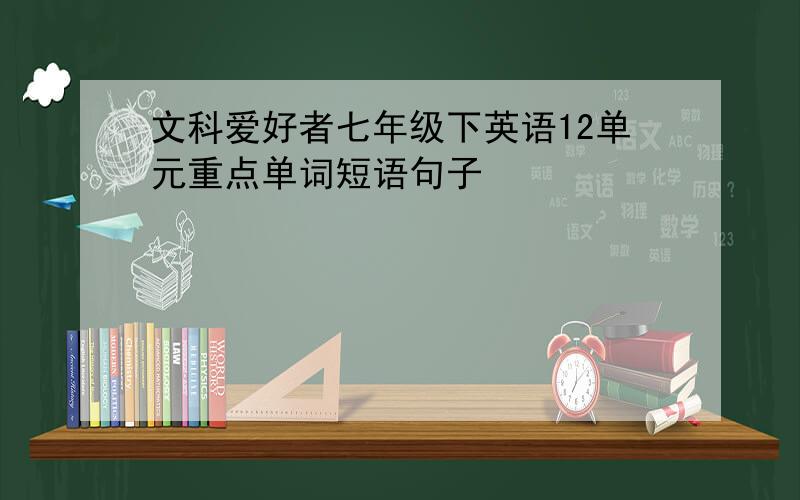文科爱好者七年级下英语12单元重点单词短语句子
来源:学生作业帮助网 编辑:作业帮 时间:2024/04/28 23:36:47

文科爱好者七年级下英语12单元重点单词短语句子
文科爱好者七年级下英语12单元重点单词短语句子
文科爱好者七年级下英语12单元重点单词短语句子
第十二单元的:Unit 12 Don't eat in class.
一.短语.
1.in class 在课上
2.on school nights 在上学的晚上
3.school rules 学校规章制度
break the rules 违反规章制度
4.no talking 禁止交谈
5.listen to music 听音乐
6.have to 不得不
7.take my dog for a walk 带狗去散步
8.eat outside 在外面吃饭
9.in the hallway 在走廊上
10.wear a uniform 穿制服
11.arrive late for class 上学迟到
12.after school 放学后
17.be in bed 在床上
13.practice the guitar 练习弹吉它
14.in the cafeteria 在自助食堂里
15.meet my friends 和我朋友见面
16.by ten o'clock.十点之前
18.the Children's Palace 少年宫
19.help my mom make dinner 帮助我妈做饭
20.in the hallways 在过道
二.重点句型
1.Don’t arrive late for school=Don’t be late for school
2.Don’t fight
3.Don’t listen to music in the classroom.
4.Don’t run in the hallways
5.Don’t smoke .It’s bad for your health.
6.Don’t play cards in school
7.Don’t talk in class
8.Don’t watch TV on school nights.
9.Don’t sleep in class.
10.Don’t play sports in the classrooms.
11.Don’t sing songs at night.
12.Don’t talk when you eat.
13.Don’t wear hats in class.
14.Do homework by 10:00.
15.Clean your house!
16.Make the bed.
17.Can we ……?Yes ,we can .No,we can’t.
18.Do you have to wash your clothes?Yes,I do./No,I don’t.
三. 重难点解析:
1.情态动词have to 的用法,意思是"必须、不得不".
(1)结构:主语+have to+动词原形+其他
(一般现在时,主语是第三人称单数时,用has to;句子是过去时,用had to.)如: We have to wear sneakers for gym class.在体育课上,我们必须穿运动鞋.Tom has to practice the guitar every day.汤姆每天必须练习弹吉它.I had to get up at 5:00 am last Monday.上周一,我不得不早上5点起床.
(2)否定形式:主语+don't have to+动词原形+其他
(一般现在时,主语是第三人称单数时,用doesn't have to.句子是过去时,用didn't have to)
Nick doesn't have to wear a uniform.尼克不必穿制服.We didn't have to do our homework at once.我们不必马上完成作业.
(3)疑问句:Do (Does或Did)+主语+have to +动词原形+其他
如:Do you have to stay at home on weekends?周末你必须呆在家里吗?Yes,I do./ No,I don't.
是的,我必须.不,我不必.Did he have to go to bed by 11:00 last night?昨晚,他不得不11点前上床睡觉吗?
2.情态动词can的用法
(1)表示能力,"会""能"(在第一册中已经学习这种用法)
Can you play the guitar?你会弹吉它吗?can在否定句中,直接在can后加上not,在疑问句中,把can放到主语前面,并且没有人称和数的变化.
5.arrive late for 与be late for 意思相近,"
6.No talking !"禁止交谈!"no后面加上名词或动名词(doing)也表示不要做某事.与don't +do的用法相似.No wet umbrellas!/ Don't put wet umbrellas here!禁止放湿雨伞!
No food!Don't eat food here!禁止吃食物!No smoking!Don't smoke here!禁止吸烟!
7.语法(祈使句)
祈使句是用来表示请求、命令、叮嘱、号召或者劝告等的句子,这类句子的主语常是第二人称you,也就是听话者,因而you常省去了.祈使句的开头是动词原形.
1)Be型(即系动词原型be+表语+其他).
如:Be quiet,please.否定句Don’t + be+表语+其他.
如:Don’t be angry.
2)Do型(即系动词原形+宾语+其他).如:
Open you books,please.否定句Don’t +实义动词原形+宾语+其他.
如:Don’t eat in the classroom.
3)Let型(即Let+宾语+动词原形+其他)如:
Let me help you.Let’s go at six o’clock.
否定句一般在宾语后加not.如:
Let’ not watch TV.
4)No+V-ing型(此种形式通常用于公共场合的提示语中,意为“禁止做某事“)如:
No smoking!严禁吸烟!No talking!不许交谈!No passing!禁止通行!No parking!不许停车
祈使句 Be+动词
Do not+动词原形
或是NO+动词ing 记住NO也可以接名词比如No food in class。
No eating
help sb.with sth
help sb.(to)do sth